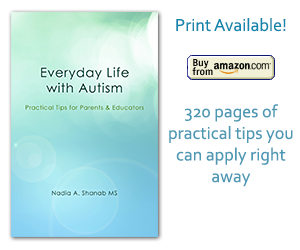By Nadia Shanab | autism
This is a summary of one of the sessions that I have attended at the Morgan Autism Center last September. The speaker, Jill Escher, narrates her own story of struggle and discoveries. She has 2 kids with “idiopathisc autism”. It is a very informative and eye-opening story that all parents should read. What causes autism
Tags: asperger's syndrome, autism, chemicals, communication, consequences, diagnosis, drugs, environmental, ferility treatment, genetics, health, IVF, neurodevelopmental conditions, pollution, research, smoking, social interaction, speech, symptoms of autism, toxins
Posted in autism | Comments Off on What Causes Autism? From Morgan Autism Center Conference
By Nadia Shanab | Uncategorized
Family gatherings are around the corner! Most people love to celebrate traditions and keep cultures. Soon you’ll receive many invitations to join lunches, dinners, parties with your family and friends. Parents with kids on the autism spectrum, tend to decline these invitations and find an excuse to escape all kinds of gatherings. As much as
Tags: asperger's syndrome, autism, communication, discipline, flexibility, health, independence, organization, parenting, sensory, social interaction, tips
Posted in Uncategorized | Comments Off on Don’t Worry! You Can Still Enjoy Holidays Gatherings
By Nadia Shanab | Uncategorized
It is never enough to emphasize the importance of being specific when interacting with individuals with autism to avoid any confusion. However, I’ve always found everything they say, and which may appear illogical to certain people, to be absolutely rational. Here are some examples: Example 1 We were reading a story and we came across
Tags: asperger's syndrome, autism, communication, flexibility, free thinkers, idioms, out of the box, parenting, senses, social interaction, tips, what's normal?
Posted in Uncategorized | Comments Off on Individuals with Autism Think out of The Box
By Nadia Shanab | autism, general advice, parenting, tips
Anecdote I was shadowing a student with autism from a Special Day Class (SDC) in a mainstream class for Math subject. The student looked around scanning the faces of all the students surrounding her. With confused and lost eyes the student looked at me and asked: “Am I a special ed student?” She was loud enough
Tags: asperger's syndrome, autism, combo class, parenting, positive psychology, schedule, social interaction, special education, tips
Posted in autism, general advice, parenting, tips | Comments Off on How to Answer The Question: “Am I A Special Ed?”
By Nadia Shanab | Uncategorized
A recent research by the Vanderbilt University, October 2013, has released a new intervention program to help improve the social deficits in adolesents with autism. Researchers used the theater to teach reciprocal communication skills. The program is called Social Emotional Neuroscience & Endocrinology (SENSE). Techniques used in this program are: role-play, improvisation, and it culminates in
Tags: acting, asperger's syndrome, autism, communication, early intervention, eye contact, flexibility, parenting, performing arts, research, social interaction, speech, techniques, theater, tips
Posted in Uncategorized | Comments Off on Acting Improves Social Skills
By Nadia Shanab | Uncategorized
Watch an interview with Temple Grandin that inspires “hope”. She briefly touches on most aspects of autism. templegrandin.com/ nadia shanab
Tags: asperger's syndrome, autism, communication, diagnosis, discipline, early intervention, flexibility, health, independence, organization, parenting, placement, research, rewards, schedule, sensory, social interaction, speech, symptoms of autism, Temple Grandin, tips
Posted in Uncategorized | Comments Off on A Message of Hope from Temple Grandin
By Nadia Shanab | Uncategorized
You may have noticed that most of my articles are about trying to help parents and educators raise and educate kids with autism. So, most of the tips I suggest are usually targeting the kids. But, how about parents and educators themselves? Can they always be in their greatest shape, best mood, and ready to provide
Tags: Abraham Lincoln, asperger's syndrome, autism, behavioral disorders, clinical psychology, communication, flexibility, happiness, health, independence, organization, parenting, positive psychology, research, social interaction, techniques
Posted in Uncategorized | Comments Off on Positive Psychology
By Nadia Shanab | Uncategorized
Individuals on the Autism Spectrum are known to be loners, anti-social, and have poor communication skills. Researchers found a corelation between a hormone that is tied to “bonding” called oxytocin, and the brain system that produce pleasure and motivation. This hormone is known as the “love” or “cuddle” chemical. Genetic changes in autistic children may
Tags: asperger's syndrome, autism, communication, diagnosis, early intervention, eye contact, neurotransmitter, oxytocin, parenting, research, serotonin, social interaction, tips
Posted in Uncategorized | Comments Off on How “Serotonin and Oxytocin” Affect The Social Behavior
By Nadia Shanab | Uncategorized
The following tips can be applied in classrooms as well as at home. Be positive in scanning the environment for possible behavioral precipitants. Reduce or eleminate stressors, to the extent possible. Read the student’s cue and signals and react before inapporopriate behavior occurs. “Plug in” activities designed to reduce stress and anxiety before behavioral disruptions
Tags: ADHD, asperger's syndrome, autism, communication, consequences, discipline, early intervention, flexibility, health, independence, mainstream, occupational therapy, parenting, placement, schedule, senses, social interaction, speech, techniques, transition, visual aids
Posted in Uncategorized | Comments Off on Tips for Behavioral Troubleshooting
By Nadia Shanab | Uncategorized
The Instructional Assistant’s Mission Statement Know well both your students and the disabilities that they manifest. Learn to take your students’ perspectives, and realize that they have significant difficulty taking yours. Always look beyond your students’ behaviors to determine the functions that those behaviors serve. Be neither blinded by your students’ strengths, nor hold them
Tags: aids, autism, communication, discipline, early intervention, flexibility, independence, organization, parenting, rewards, schedule, sensory, social interaction, speech, symptoms of autism, tips, visual aids
Posted in Uncategorized | Comments Off on Tips for Instructional Assistants

